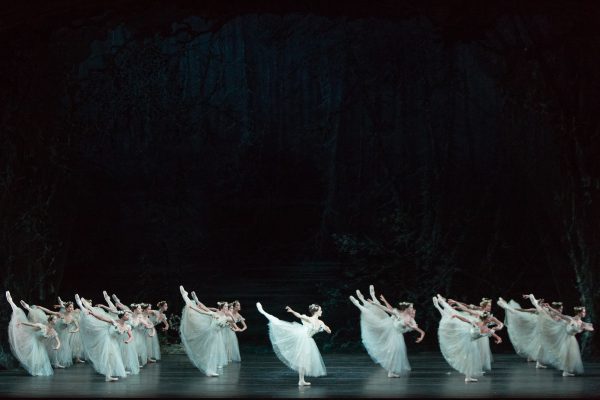What would you sacrifice for the chance to be happy?
The National Ballet of Canada’s production of La Sylphide explored this question with a faithful rendition of one of the world’s oldest ballets, while giving the story a subtly contemporary treatment that made the production relatable for the modern audience attending on opening night, March 2.
La Sylphide tells the story of a dashing young Scot, James, who leaves his life behind on his wedding day to pursue a relationship with an enchanted creature in the forest. With the interference of a wicked witch, a merry band of friends and bad decisions, chaos ensues.
Morning breaks with James (Harrison James) asleep by the fire. His strong figure exudes human potential yet sits motionless, lost and small in his lavish yet neglected home. Desmond Heeley’s set deftly captures the reality of a life one could be comfortable in but isn’t.
Jurgita Dronina plays the part of the winged creature beautifully. Her playful lightness is instantly attractive. The spotlight on her white gown elevates her movement to a glittering light in the dark. Who wouldn’t fall in love with her? Dronina enchants with her delicate, precise footwork. That said, in this first scene her upper body maintained too much structure, feeling heavy compared to her spritely footwork. While the Bournonville style of this ballet does demand a more held port de bras to showcase its characteristically complex footwork, the arms are supposed to serve as a graceful melody, moving to the intricate rhythm of the feet. Dronina’s Act I execution was a slight miss.
Robert Thomson’s lighting design deserves special mention beyond the brilliant way he highlights Dronina even when she’s surrounded by dancers in similar costumes. Throughout the production he subtly illuminates key themes. In the next scene, as wedding preparations are in full swing, Thomson fills the stage with light and purposefully chooses not to highlight James’ fiancée Effie (Jillian Vanstone). The lighting itself suggests that Effie just doesn’t shine in James’ eyes as she should. Even without a spotlight, Vanstone creates a truly loveable girl. Her every movement was soft, full and emotive.
Despite being unexpectedly thrust into the leading role on opening night, Harrison James’ execution was so well done it’s hard to imagine a better casting. He covered the entire range of the character with depth and authenticity. At times he restrained his clearly considerable athleticism, at others he launched into every extension and leap with jubilant abandon. Even the way he walked across the stage, with a regal air that set him apart from his friends and family, supported the storyline.
The dancers portray less than domestic bliss in Act I and add a layer of complexity to the story beyond the apparent morality play that is the plotline. This smart performance choice makes the production relevant in a contemporary context. Instead of being a loathsome character for leaving his fiancée, James is rendered surprisingly sympathetic. You want to hate James but you can’t. In a video interview on The National Ballet of Canada’s website, Director Johan Kobborg comments on the choice the character faces: “It’s a theme we can all relate to …The Sylph can represent whatever you want it to represent.” The Sylph is every lover, job and dream you ever wanted, and James has the courage to pursue it. No wonder it’s so hard to detest James for the wreckage he causes.
The team successfully presents two sharply contrasting pas de deux. In Act I, Effie and James move in perfect harmony with an aura of routine and safety. In contrast, the Act II pas de deux between James and the Sylph is so joyful and exciting that his choice makes sense. Even without touching, the two lead dancers are perfectly connected. The chemistry between the dancers and snappy interplay of their steps is irresistibly captivating.
As compared to his set choices Heeley’s costumes are not always a perfect fit. The Scots’ costumes, though charming, created a shifting maze of argyle that made it hard to see the dancers’ movements during the Act I reel. James’ plush jacket seemed just a bit too noble for a farmer.
Of course, this is not one of those ballets with a happy ending. As Kobborg said, “He (James) follows his heart … when you do that things can go wrong”. James falls into the trap of taking bad advice from a bad source, in his case, Sonia Rodriguez’s impressively angular and deliciously evil Madge. While she effectively burned with bitter guile, Rodriguez’s energetic and sharp gesticulations didn’t come off as believably old.
In the final scene, as the Sylph dies in James’ arms, the corps de ballet really shines. They become an extension of Dronina, their arms softly rising and falling in perfect unison to collectively breathe in her last breaths. They form elegant and precise visual lines becoming a greater organic presence.
As Kobborg has said, “It’s not always about the outcome. It’s about the journey” and one is left wondering. Were those moments of complete joy really worth it? Kobborg’s staging resurrected music and choreography from August Bournonville’s hand-written notes. While it was fascinating to look back in time, the many mime sections left the audience longing for movement. Overall though, this was a thought-provoking take that made one of the world’s oldest surviving ballets compelling and relevant today.
The National Ballet of Canada performs La Sylphide from March 2 through 6, 2016 at the Four Seasons Centre in Toronto.





